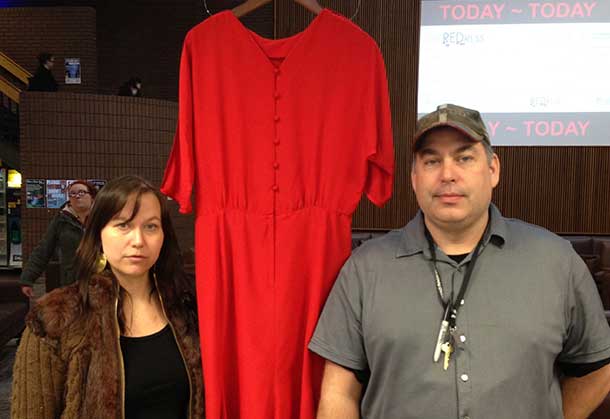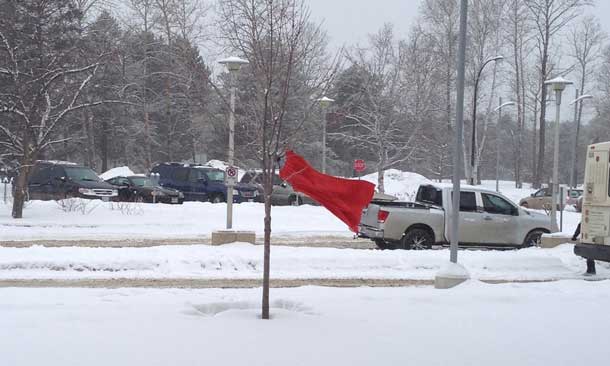

THUNDER BAY, ON – The Student Union of Confederation College (SUCCI) has brought the REDress Project to campus this week. The REDress Project, focuses around the issue of missing or murdered Aboriginal women across Canada. It is an installation art project based on an aesthetic response to this critical national issue. The project was created by Jaime Black, an emerging, metis multidisciplinary artist based in Winnipeg. The project has been installed at the Canadian Museum for Human Rights in Winnipeg and is being installed in public spaces, such as the College, across Canada.
Confederation College’s Thunder Bay Campus will be seeing red until March 11 with approximately 100 red dresses displayed throughout each building as well as outdoors on the College property. The dresses represent all ages and roles that women hold in society. The art exhibition was launched with a discussion circle, moderated by the artist. The exhibition and discussion circle are designed to raise awareness and provoke an important conversation about the issue.

“As soon as I learned about the REDress Project I knew I wanted to host the exhibit at the College to raise awareness around the issue of missing and murdered Aboriginal women,” said Chris Cartwright, President of the Student Union. “I want students to realize that this issue is everyone’s issue. As people visit the campus over the next week, my hope is that they will be inspired by the haunting beauty of the dresses to further investigate the issue on their own.”
Jaime Black studied English Literature at the University of Manitoba and has an Education degree from The Ontario Institute of Studies in Education. She has taught in Opaskwayak Cree Nation in the Pas, Manitoba, has worked developing art curriculum for the Urban Shaman: Contemporary Aboriginal Art, and has long been involved in the Aboriginal writers and artists communities in Winnipeg. She is currently a mentee with Mentoring Artists for Womens Art (MAWA).
In her artwork, she attempts to create a dialogue around social and political events and issues, through provocation or creating space for reflection. She is particularly interested in feminism and Aboriginal social justice, and the possibilities for articulating linkages between and around these movements.
“My work is informed by and emerges from the places where the social, cultural, political and personal intersect,” said Black. “I use my work as a tool for exploring, connecting and questioning our current and historical socio-political framework and the ways in which we behave within that framework. I aim to provoke and incite dialogue around these issues by making work that provides viewers with the opportunity to approach them from a different perspective. The REDress project is meant to be a visual reminder of the staggering number of women who are no longer with us. Through the installation I hope to draw attention to the gendered and racialized nature of violent crimes against Aboriginal women and to evoke a presence through the marking of absence.”
Members of the public are welcome to stop by campus to experience the installation until March 11. For more information on the project, visit www.redressproject.org.





